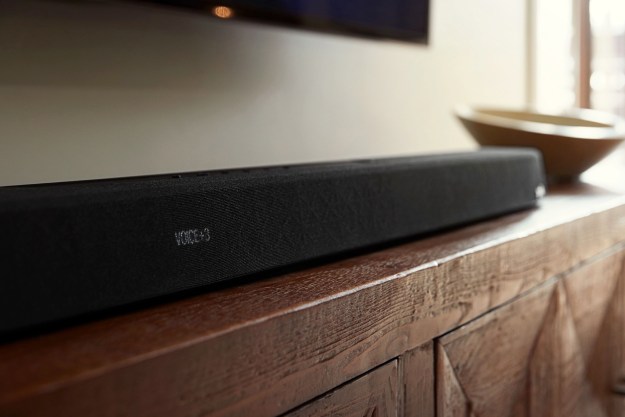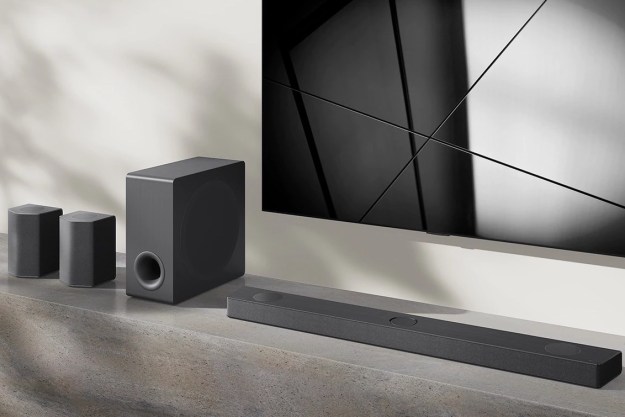
“Yamaha’s YAS-209 offers an embarrassment of riches at an affordable price.”
- Clear, powerful sound
- Multiple sound modes
- Built-in Alexa
- Wi-Fi and Spotify Connect
- No independent Alexa volume control
Yamaha’s YAS-207 blew away the crowd upon its 2017 debut, offering a heady mix of clear and balanced performance and more features than a $300 soundbar has any right to. That put it at the top of our best soundbars list, where it has remained for two years.
For its follow-up, the YAS-209 (what dark fate the 208 met, we’ll never know), Yamaha has stuck with the 207 playbook, while also offering even more extras — including built-in Amazon Alexa — at a $50 markup. Frankly, the 207 is still a killer deal two years on, but a few more goodies doesn’t hurt the formula one bit, making the 209 another winner in Yamaha’s long list of value-packed bars.
Stealthy sound
I’m not saying the YAS-209’s design is boring, but if you looked up the word “nondescript” in the dictionary, well, you’d find no pictures of it because dictionaries typically don’t have pictures, but you get the point. In any case, even more so than its predecessor, the 209 is virtually invisible beneath your TV, which Yamaha claims is just how its customers want it.

A tubular, black brick wrapped in acoustical fabric, the only thing that keeps the 209 from completely disappearing is its rudimentary LED display which, while set on top of the unit, is still visible from your seat on the couch. The basic system provides cues for volume and subwoofer level from afar, while indicating settings like source, surround sound, and Yamaha’s Clear Voice setting upon a closer look. I’d complain about the lack of a substantial digital display, but the LED solution has become so common in the segment, I’ve run out of hot air on that one.
The side-firing subwoofer looks almost exactly like a PC tower (save the glossy port in the front end) and begs to be stowed out of sight for its own anonymous existence.
The driver dimensions for both the 207 and 209 are exactly the same, including dual 1-inch tweeters and four 1¾-inch drivers in the bar, and a 6¼-inch woofer in the sub cabinet. Yamaha says the 209’s drivers and amplifiers have been redesigned for improved clarity, and while I’m not sure I heard any major change, it remains a formidable collection at this price.
Loaded bar
Alongside the LEDs on the top of the bar are all the basic control keys you’d expect from a standard bar (power, volume, source, etc.), as well as a quick key for summoning
At the back hub, you’ll find digital ports including HDMI ARC for connecting to your TV, a second HDMI port to connect a streamer or media player directly, Optical digital connection, and, new for this year, both Ethernet and Wi-Fi. Bluetooth streaming is also included, of course, but Spotify fans can now stream over Wi-Fi via Spotify Connect for higher sound quality. One omission is any analog connection, something we’re starting to see left out more often these days. It won’t really affect most folks, but if you want to connect an analog device like a turntable, you’ll need an adapter.
Spotify fans can now stream over Wi-Fi via Spotify Connect.
Yamaha has souped up its remote slightly, bending it into a curvier plate of plastic. It boasts a wide array of buttons that signify the bounty of features you get for your money. There are quick keys for Source (including “TV” for the ARC or Optical input); multiple surround sound/EQ modes like TV, Movie, Music, and Sports; as well as a Stereo key, which I vastly prefer over the other choices for music. Most basic functions are also controllable via the Yamaha Sound Bar controller app

The remote also sports a key for Yamaha’s aforementioned Clear Voice feature (which I regularly leave engaged for heightened clarity), and a 3D Surround key that activates the DTS Virtual:X feature. Virtual:X allows for a broader soundstage on the vertical axis, as well as the horizontal, for a more expansive soundstage. It definitely expands the imaging a bit more, though as I’ve come to expect, the trade-off is less weight to the upper midrange and treble registers. Yamaha claims this has been improved upon over the 207, and I did notice less icy sibilance this time around.
As far as audio formats, the 209 supports Dolby Digital, Dolby Pro Logic II and DTS Digital Surround decoding. On the video side, 4K HDR passthrough is supported, but you can’t pass
Let’s talk Alexa
Full disclosure, I’m not a huge fan of
As for functionality, the system allows for rudimentary soundbar controls like volume up/down, mute, and source switching (though you can’t switch EQ modes), all of which can be done by either calling out to

That’s all well and good, but more exciting to this reviewer is forthcoming multiroom speaker support, which will be added by year’s end, according to Yamaha PR. While the YAS-209 offers Wi-Fi streaming and control, it isn’t a MusicCast device, meaning it can’t sync up with other MusicCast speakers in Yamaha’s family. Once it’s added via Amazon, though, anyone with
One complaint I’ll register is that there’s no obvious way to lower Alexa’s volume independently, meaning if you’re listening to quieter content and you call on
Setup
Setting up the YAS-209 is extremely easy — as long as you’ve got an HDMI cable, as the 209 doesn’t arrive with one. HDMI ARC is the preferred connection, which allows for easy control of volume and power with your TV remote (though you may need to turn CEC on in your TV’s settings). You’ll want a cable to connect, as my first attempt with an older one didn’t pass audio. While Yamaha is far from the first to omit all the cables you need, I’m going to go ahead and say this now: All soundbars with HDMI ARC need to include an HDMI cable!
One other point of note: My TCL 6-series TV remote worked fine for volume and power, but wouldn’t power the unit down. This is the second bar in as many reviews in which I’ve faced this issue, so it would appear to be a TCL communication problem as much as a Yamaha one, and the unit worked perfectly with the LG SM900P in our office testing room. Again, for TCL owners, here’s hoping Yamaha corrects this.
Performance
For those who’ve read reviews for the Yamaha YAS-207 (hopefully including mine), there won’t be a ton of surprises here — and that’s a good thing. Like its predecessor, the YAS-209 brings to bear a smooth and relatively well-defined midrange, solid clarity up high, and plenty of thump from that squared-up subwoofer to hype up all your favorite films — all at a still-affordable price point.
The 209 serves up sneaky-good detail in your favorite films and TV shows, without punching you in the ears with sharpness or sibilance. While the ting of spears or the metallic clicks of Black Panther’s helmet aren’t as expressive in the titular film as they are with Klipsch’s similarly priced Bar 40, the Yamaha does a better job balancing all the elements, especially when it comes to bombastic action scenes like the Busan car chase, where the screeching wheels, pumping machine gun blasts, and various explosions are all richly rendered.
The 209 serves up sneaky-good detail for your favorite films and TV shows.
I especially like the dusty pulp to the YAS-209’s midrange that folds into your ears with just the right touch, whether it’s the whopping rotor from a helicopter in The Rock’s Rampage or streaming instruments like acoustic guitar and snare drum. While I was far from bowled over, the YAS-209 also does relatively well with music for its price point, faltering only with some tinny brightness in cymbals and other high-frequency instruments. Frankly, it’s not going to be a hi-fi musical experience, but at $350 it doesn’t have to be — especially with so many features.
As alluded to above, I’m still not a fan of DTS Virtual:X in most scenarios due to the sharpness it lends to the treble, although this time around it did better when it comes to expanding the YAS-209’s soundstage pleasantly in powerful cinematic action scenes. The problem is, after the action simmers down, I usually find myself wishing to disengage it again, forcing me to seek out the remote. Luckily, it’s easy to make adjustments to EQ, soundstage and subwoofer level on the fly and, like the YAS-207, you may need to do so when switching between sources if you want the optimal experience.
Overall, the YAS-209 is an impressive upgrade over your TV sound to be sure, and at times it seriously surprises with its penchant for detail, precision, and power.
Yamaha’s new YAS-209 offers an embarrassment of riches at its price point, from Wi-Fi connection and
Is there a better alternative?
Frankly, the best alternative (especially for those who don’t care about
On the other side are more affordable options like Vizio’s SB3621n-GB which drops a fair few features, but offers solid sound at less than half the price.
How long will it last?
The only concerns on longevity here are the soundbar’s lack of future-looking features like HDR10+ and
Should you buy it?
Yes. That’s a double yes if you’re looking for
Editors' Recommendations
- Best soundbar deals: Save on Bose, Samsung, Vizio, and more
- Kanto’s new Ren active speakers with HDMI take aim at your TV room
- How to buy a soundbar: from size to subwoofers, which is the best for you?
- Amazon debuts its first Fire TV soundbar and faster Fire TV sticks
- TCL’s 2023 soundbars are affordable, but lack a key feature


